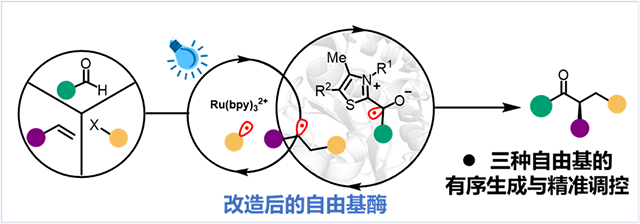

With the support of the National Natural Science Foundation of China
projects (approval numbers: 22277053, 22122305, 21927814, 223B2703), the
collaborative team of Huang Xiaoqiang from Nanjing University and Wang Binju
from Xiamen University has made new progress in the field of photocatalytic
catalysis. The related achievements are titled "Synergistic Photobiocatalysis
for Enantioselective Triple Radical Sorting" and were published online in the
journal Nature on November 22, 2024. The paper link is:
https://www.nature.com/articles/s41586-024-08399-5 .
Enzymes, as catalysts in nature, play a crucial role in various
physiological processes of living systems, and are also indispensable tools in
basic research and multiple application fields such as biomanufacturing.
Although significant progress has been made in the field of enzyme catalysis in
recent years, most of the enzymatic reactions currently studied are limited to
single-molecule or bimolecular transformations. To achieve ordered conversion of
three different substrates regulated by a single protein, there are still
significant challenges. Based on this, the team ingeniously integrated [Ru (bpy)
3] 2+- based photocatalytic and protein directed evolution techniques to
"reshape" benzaldehyde lyase into a novel free radical enzyme that catalyzes non
natural three component reactions (Figure). The team adopted a semi rational
iterative substitution point specific mutation strategy, introducing 5 mutation
sites to rapidly reconstruct the enzyme's active pocket, effectively improving
the efficiency of non natural reactions, and accurately guiding pre chiral free
radical intermediates to complete high stereochemical selectivity bonding
processes. The advantage of this system lies in its ability to flexibly combine
three variable substrates, breaking through the limitations of natural enzymes
that typically catalyze single-molecule or bimolecular transformations, and
enriching the possibilities and diversity of photo biosynthesis. The team
conducted in-depth exploration of the reaction mechanism of the system through
various methods such as enzymatic experiments, photochemical experiments,
electron paramagnetic resonance spectroscopy research, and theoretical
calculations, providing ideas for the development of new catalytic modes in the
future.